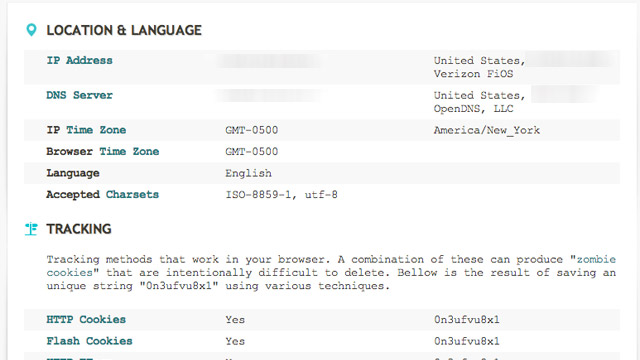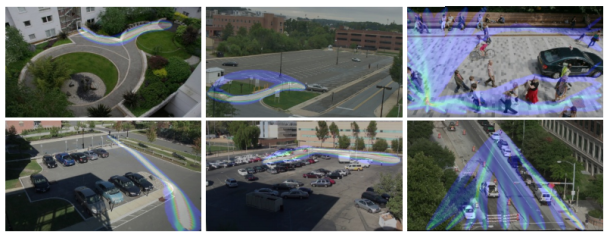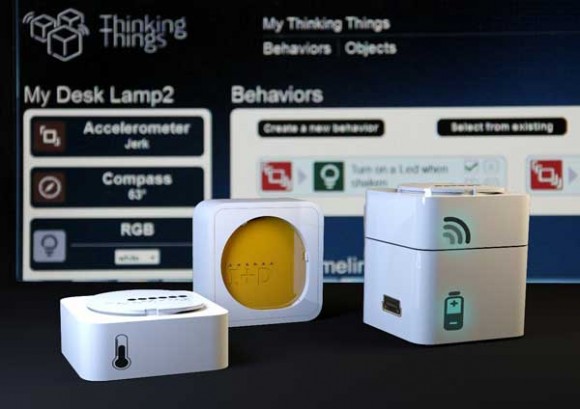Saturday, November 17. 2012
StayInvisible Analyzes Your Online Privacy and Anonymity
Via Life Hacker
-----

How anonymous are you when browsing online? If you're not sure, head to StayInvisible, where you'll get an immediate online privacy test revealing what identifiable information is being collected in your browser.
The site displays the location (via IP address) and language collected, possible tracking cookies, and other browser features that could create a unique fingerprint of your browser and session.
If you'd prefer your browsing to be private and anonymous, we have lots of guides for that. Although StayInvisible no longer has the list of proxy tools we mentioned previously, the site is also still useful if you want to test your proxy or VPN server's effectiveness. (Could've come in handy too for a certain CIA director and his biographer.)
Friday, November 16. 2012
Misc. Gadgets Voxeljet 3D printer used to produce Skyfall's Aston Martin stunt double
Via engadget
-----
Spoiler alert: a reoccurring cast member bids farewell in the latest James Bond flick. When the production of Skyfall called for the complete decimation of a classic 1960s era Aston Martin DB5, filmmakers opted for something a little more lifelike than computer graphics. The movie studio contracted the services of Augsburg-based 3D printing company Voxeljet to make replicas of the vintage ride. Skipping over the residential-friendly MakerBot Replicator, the company used a beastly industrial VX4000 3D printer to craft three 1:3 scale models of the car with a plot to blow them to smithereens. The 18 piece miniatures were shipped off to Propshop Modelmakers in London to be assembled, painted, chromed and outfitted with fake bullet holes. The final product was used in the film during a high-octane action sequence, which resulted in the meticulously crafted prop receiving a Wile E. Coyote-like sendoff. Now, rest easy knowing that no real Aston Martins were harmed during the making of this film. Head past the break to get a look at a completed model prior to its untimely demise.

Thursday, November 15. 2012
Israel Announces Gaza Invasion Via Twitter, Marks The First Time A Military Campaign Goes Public Via Tweet
Via Fast Company
-----
The Israeli military issued the world's first announcement of a military campaign via Twitter today with the disclosure of a large-scale, ongoing operation in Gaza. The Twitter announcement was made before a press conference was held.

A major Israeli military campaign in the Gaza Strip was announced today via Twitter in lieu of a formal press conference. The Israeli Defense Forces' official @IDFSpokesperson Twitter feed confirmed “a widespread campaign on terror sites & operatives in the #Gaza Strip,” called Operation Pillar of Defense, at approximately 9:30 a.m. Eastern time. Shortly before the tweet, Hamas' military head Ahmed al-Jabari was killed by an Israeli missile strike--Israel's military claims al-Jabari was responsible for numerous terror attacks against civilians. The IDF announcement on Twitter was the first confirmation made to the media of an official military campaign.
The Israeli military incursion follows months of rising tension in Gaza and southern Israel. More than 100 rockets have been fired at Israeli civilian targets since the beginning of November 2012, and Israeli troops have targeted Hamas and Islamic Jihad forces inside Gaza in attacks that reportedly included civilian casualties. According to the IDF spokespersons' office, the Israeli military is “ready to initiate a ground operation in Gaza” if necessary. Hamas' military wing, the Al-Qassam Brigades, operates the @alqassambrigade Twitter feed, which confirmed al-Jabari's death.
Wednesday, November 14. 2012
Spike in government surveillance of Google
Via BBC
-----
Governments around the world made nearly 21,000 requests for access to Google data in the first six months of this year, according to the search engine.
Its Transparency Reportindicates government surveillance of online lives is rising sharply.
The US government made the most demands, asking for details 7,969 times in the first six months of 2012.
Turkey topped the list for requests to remove content.
Government 'bellwether'
Google, in common with other technology and communication companies, regularly receives requests from government agencies and courts around the world to have access to content.
It has been publishing its Transparency Report twice a year since 2009 and has seen a steady rise in government demands for data. In its first report in 2009, it received 12,539 requests. The latest figure stands at 20,939.
"This is the sixth time we've released this data, and one trend has become clear: government surveillance is on the rise," Google said in a blog post.
The report acts as a bellwether for government behaviour around the world, a Google spokeswoman told the BBC.
"It reflects laws on the ground. For example in Turkey there are specific laws about defaming public figures whereas in Germany we get requests to remove neo-Nazi content," she said.
"And in Brazil we get a lot of requests to remove content during elections because there is a law banning parodies of candidates.
"We hope that the report will shed light on how governments interact with online services and how laws are reflected in online behaviour," she added.
The US has consistently topped the charts for data requests. France, Germany, Italy, Spain and the UK are also in the top 10.
In France and Germany it complied with fewer than half of all requests. In the UK it complied with 64% of requests and 90% of requests from the US.
Removing content
Google said the top three reasons cited by government for content removal were defamation, privacy and security.
Worldwide authorities made 1,789 requests for Google to remove content, up from 1,048 requests for the last six months of 2011.
In the period from January to June, Turkey made 501 requests for content removal.
These included 148 requests related to Mustafa Kemal Ataturk - the first president of Turkey, the current government, national identity and values.
Others included claims of pornography, hate speech and copyright.
Google has its own criteria for whether it will remove content - the request must be specific, relate to a specific web address and have come from a relevant authority.
In one example from the UK, Google received a request from police to remove 14 search results that linked to sites allegedly criticising the police and claiming individuals were involved in obscuring crimes. It did not remove the content.
Thursday, November 08. 2012
TouchDevelop Now Available as Web App
Via Technet
-----
If you’re a software developer—or if you follow the work of software developers—you’ve probably heard of TouchDevelop,
a Microsoft Research app that enables you to write code for your phone
using scripts on your phone. Its ability to bring the excitement of
programming to Windows Phone 7 has reaped lots of enthusiasm from the
development community over the past year or so.
Now, the team behind TouchDevelop has taken things a step further, with a web app that can work on any Windows 8
device with a touchscreen. You can write Windows Store apps simply by
tapping on the screen of your device. The web app also works with a
keyboard and mouse, but the touchscreen capability means that the
keyboard is not required. To learn more, watch this video.
This reimplementation of TouchDevelop went live just in time for Build,
Microsoft’s annual conference that helps developers learn how to take
advantage of Windows 8. The conference is being held Oct. 30-Nov. 2 in
Redmond, Wash.
“Just as users could turn their scripts into Windows Phone apps,” says Nikolai Tillmann, principal research software-design engineer with the Research in Software Engineering (RiSE) team at Microsoft Research Redmond, “we will also allow our users to turn their scripts into Windows Store apps.”
The TouchDevelop web app, which requires Internet Explorer 10,
enables developers to publish their scripts so they can be shared with
others using TouchDevelop. As with the Windows Phone version, a
touchdevelop.com cloud service enables scripts to be published and
queried, and when you log in with the same credentials, all of your
scripts are synchronized between all your platforms and devices.
While
in the TouchDevelop web app, users can navigate to the properties of an
installed script already created. Videos describing editor operation of
the TouchDevelop web app are available on the project’s webpage.
TouchDevelop shipped as a Windows Phone app about a year and a half ago and has seen strong downloads and reviews in the Windows Phone Store.
“Our
TouchDevelop app for Windows Phone has been downloaded more than
200,000 times,” Tillmann says, “and more than 20,000 users have logged
in with a Windows Live ID or via Facebook.”
Since
the app became available, Tillmann and his RiSE colleagues have been
astounded by the creativity the user base has demonstrated. Further
Windows 8 developer excitement will be on display during Build, which is being streamed to audiences worldwide.
Tuesday, November 06. 2012
I.B.M. Reports Nanotube Chip Breakthrough
-----
SAN FRANCISCO — I.B.M. scientists are reporting progress in a chip-making technology that is likely to ensure that the basic digital switch at the heart of modern microchips will continue to shrink for more than a decade.
The advance, first described in the journal Nature Nanotechnology on Sunday, is based on carbon nanotubes — exotic molecules that have long held out promise as an alternative to silicon from which to create the tiny logic gates now used by the billions to create microprocessors and memory chips.
The I.B.M. scientists at the T.J. Watson Research Center in Yorktown Heights, N.Y., have been able to pattern an array of carbon nanotubes on the surface of a silicon wafer and use them to build hybrid chips with more than 10,000 working transistors.
Against all expectations, silicon-based chips have continued to improve in speed and capacity for the last five decades. In recent years, however, there has been growing uncertainty about whether the technology would continue to improve.
A failure to increase performance would inevitably stall a growing array of industries that have fed off the falling cost of computer chips.
Chip makers have routinely doubled the number of transistors that can be etched on the surface of silicon wafers by shrinking the size of the tiny switches that store and route the ones and zeros that are processed by digital computers.
The switches are rapidly approaching dimensions that can be measured in terms of the widths of just a few atoms.
The process known as Moore’s Law was named after Gordon Moore, a co-founder of Intel, who in 1965 noted that the industry was doubling the number of transistors it could build on a single chip at routine intervals of about two years.
To maintain that rate of progress, semiconductor engineers have had to consistently perfect a range of related manufacturing systems and materials that continue to perform at evermore Lilliputian scale.

I.B.M. Research Vials contain carbon nanotubes that have been suspended in liquid.
The I.B.M. advance is significant, scientists said, because the chip-making industry has not yet found a way forward beyond the next two or three generations of silicon.
“This is terrific. I’m really excited about this,” said Subhasish Mitra, an electrical engineering professor at Stanford who specializes in carbon nanotube materials.
The promise of the new materials is twofold, he said: carbon nanotubes will allow chip makers to build smaller transistors while also probably increasing the speed at which they can be turned on and off.
In recent years, while chip makers have continued to double the number of transistors on chips, their performance, measured as “clock speed,” has largely stalled.
This has required the computer industry to change its designs and begin building more so-called parallel computers. Today, even smartphone microprocessors come with as many as four processors, or “cores,” which are used to break up tasks so they can be processed simultaneously.
I.B.M. scientists say they believe that once they have perfected the use of carbon nanotubes — sometime after the end of this decade — it will be possible to sharply increase the speed of chips while continuing to sharply increase the number of transistors.
This year, I.B.M. researchers published a separate paper describing the speedup made possible by carbon nanotubes.
“These devices outperformed any other switches made from any other material,” said Supratik Guha, director of physical sciences at I.B.M.’s Yorktown Heights research center. “We had suspected this all along, and our device physicists had simulated this, and they showed that we would see a factor of five or more performance improvement over conventional silicon devices.”
Carbon nanotubes are one of three promising
technologies engineers hope will be perfected in time to keep the
industry on its Moore’s Law pace.
Graphene is another promising
material that is being explored, as well as a variant of the standard
silicon transistor known as a tunneling field-effect transistor.
Dr. Guha, however, said carbon nanotube materials had more promising performance characteristics and that I.B.M. physicists and chemists had perfected a range of “tricks” to ease the manufacturing process.
Carbon nanotubes are essentially single sheets of carbon rolled into tubes. In the Nature Nanotechnology paper, the I.B.M. researchers described how they were able to place ultrasmall rectangles of the material in regular arrays by placing them in a soapy mixture to make them soluble in water. They used a process they described as “chemical self-assembly” to create patterned arrays in which nanotubes stick in some areas of the surface while leaving other areas untouched.
Perfecting the process will require a more highly purified form of the carbon nanotube material, Dr. Guha said, explaining that less pure forms are metallic and are not good semiconductors.
Dr. Guha said that in the 1940s scientists at Bell Labs had discovered ways to purify germanium, a metal in the carbon group that is chemically similar to silicon, to make the first transistors. He said he was confident that I.B.M. scientists would be able to make 99.99 percent pure carbon nanotubes in the future.
Monday, November 05. 2012
Android 4.2 Announced: Photo Sphere, Gesture Typing, Multi-User, TV Connect, Quick Settings, and Much More!
Via xda developpers
-----
Retaining the code name from Android 4.1, 4.2 is a revamped version of Jelly Bean. Despite the lack of name change, 4.2 offers various new and exciting features. Join us as we take a closer look at some of the highlights!
Photo Sphere and Camera UI Improvements
Not too long ago, Google gave us native support for panoramic photos with the launch of ICS. However, in their eyes, a standard panoramic shot doesn’t properly convey the feeling of actually being there. Photo Sphere takes us one step closer.
Once Photo Sphere mode is enabled, the app first guides you as you move your device to capture the entire scene. By using the same technology employed by Google Maps Street View, Photo Sphere then stitches the shots into a 360-degree view that allows you to pan and zoom, as you would in Street View. Those wishing to look at photo spheres from photographers around the would can do so as well.
In addition to Photo Sphere, the Camera app’s UI also been updated with gesture controls. Thanks to the gestures, the interface no longer obscures the photo being taken with various controls. Instead, the app now makes full use of the screen real estate so that you can take better photos.
Gesture Typing
Taking a page from Swype’s play book, the new keyboard built into Android 4.2 has slide gesture functionality. The heavily revised keyboard differentiates itself from current versions of Swype, however, by showing predictions in real time, as you slide around your fingers.
This isn’t the first time we’ve seen real time gesture recognition—dubstep aside. That said, the interface looks to be better on Google’s latest offering, but the real test will be in actual day to day usage. The dictionaries have also been updated, as has voice recognition.
Multi-User
Remember all the buzz about enabling multi-user support on Android? Apparently, Google does too. We all knew this was coming; it was only a matter of “when.”
Well, it’s finally here. Multi-User support has finally made its way to the OS officially. Each user is given his or her own personal space, complete with a customized home screen, background, widgets, apps, and games. While we don’t have access to the source code to verify, this is likely accomplished by sectioning off the /data partition between users. Interestingly, switching between user profiles is done via fast user switching, rather than completely logging in and out.
Naturally, this feature is only available / practical on tablets, but you can bet your bacon that this will find its way to phones in the coming months, after 4.2 is released to AOSP.
TV Connect
 Many were disappointed to learn that the Nexus Q was only able to stream Google Play content rather
than supporting full device mirroring. Problem, no more. In Android
4.2, users will be able to wirelessly mirror their displays to various
supported devices.
Many were disappointed to learn that the Nexus Q was only able to stream Google Play content rather
than supporting full device mirroring. Problem, no more. In Android
4.2, users will be able to wirelessly mirror their displays to various
supported devices.
While we can’t speak in regards to additional functionality for Google’s enigmatic black orb, we can say that this will truly be a useful feature if executed properly. The underlying technology is the new industry standard Miracast, which was created by the Wi-Fi Alliance, and is based on Wi-Fi Direct.
DayDream
A fun, new feature present in 4.2 allows your device to display photo albums, news, and more when your device is docked.
Quick Settings
Remember AP’s video showing the “future site of quick settings?” It’s finally here. Google has now added a separate panel to the notification bar that can be accessed by a two-finger swipe from the top of the screen or simple button tap in the upper right corner if the notification tray is extended. Once summoned, it gives you quick access to user accounts, brightness, device settings, WiFi, Airplane Mode, Bluetooth, Battery, and Wireless Display.
Lock Screen Widgets
Much as we have seen in third party applications, Android now natively supports widgets on the lock screen. In fact, you can now add several pages of widgets to your device’s lock screen, essentially giving you a home screen—before you get to your home screen. Memetastic.
Enhanced Google Now
Google Now was also updated with more cards. A good example of this is how the software can pick out shipping updates and flight details from your email, and display them in a context-relevant manner. This, however, is not exclusively tied with the updated OS, as those with devices running 4.1 can access the update today.
Friday, November 02. 2012
U.S. looks to replace human surveillance with computers
Via c|net
-----
Security cameras that watch you, and predict what you'll do next, sound like science fiction. But a team from Carnegie Mellon University says their computerized surveillance software will be capable of "eventually predicting" what you're going to do.

Computerized surveillance can predict what people will do next -- it's called "activity forecasting" -- and eventually sound the alarm if the action is not permitted. Click for larger image.
(Credit: Carnegie Mellon University)Computer software programmed to detect and report illicit behavior could eventually replace the fallible humans who monitor surveillance cameras.
The U.S. government has funded the development of so-called automatic video surveillance technology by a pair of Carnegie Mellon University researchers who disclosed details about their work this week -- including that it has an ultimate goal of predicting what people will do in the future.
"The main applications are in video surveillance, both civil and military," Alessandro Oltramari, a postdoctoral researcher at Carnegie Mellon who has a Ph.D. from Italy's University of Trento, told CNET yesterday.
Oltramari and fellow researcher Christian Lebiere say automatic video surveillance can monitor camera feeds for suspicious activities like someone at an airport or bus station abandoning a bag for more than a few minutes. "In this specific case, the goal for our system would have been to detect the anomalous behavior," Oltramari says.
Think of it as a much, much smarter version of a red light camera: the unblinking eye of computer software that monitors dozens or even thousands of security camera feeds could catch illicit activities that human operators -- who are expensive and can be distracted or sleepy -- would miss. It could also, depending on how it's implemented, raise similar privacy and civil liberty concerns.

Alessandro Oltramari, left, and Christian Lebiere say their software will "automatize video-surveillance, both in military and civil applications."
(Credit: Carnegie Mellon University)A paper (PDF) the researchers presented this week at the Semantic Technology for Intelligence, Defense, and Security conference outside of Washington, D.C. -- today's sessions are reserved only for attendees with top secret clearances -- says their system aims "to approximate human visual intelligence in making effective and consistent detections."
Their Army-funded research, Oltramari and Lebiere claim, can go further than merely recognizing whether any illicit activities are currently taking place. It will, they say, be capable of "eventually predicting" what's going to happen next.
This approach relies heavily on advances by machine vision researchers, who have made remarkable strides in last few decades in recognizing stationary and moving objects and their properties. It's the same vein of work that led to Google's self-driving cars, face recognition software used on Facebook and Picasa, and consumer electronics like Microsoft's Kinect.
When it works well, machine vision can detect objects and people -- call them nouns -- that are on the other side of the camera's lens.
But to figure out what these nouns are doing, or are allowed to do, you need the computer science equivalent of verbs. And that's where Oltramari and Lebiere have built on the work of other Carnegie Mellon researchers to create what they call a "cognitive engine" that can understand the rules by which nouns and verbs are allowed to interact.
Their cognitive engine incorporates research, called activity forecasting, conducted by a team led by postdoctoral fellow Kris Kitani, which tries to understand what humans will do by calculating which physical trajectories are most likely. They say their software "models the effect of the physical environment on the choice of human actions."
Both projects are components of Carnegie Mellon's Mind's Eye architecture, a DARPA-created project that aims to develop smart cameras for machine-based visual intelligence.
Predicts Oltramari: "This work should support human operators and automatize video-surveillance, both in military and civil applications."
Thursday, November 01. 2012
Telefonica Digital shows off Thinking Things for connecting stuff to the web
Via Slash Gear
-----
Telefonica Digital has unveiled a new plastic brick device designed to connect just about anything you can think of to the Internet. These plastic bricks are called Thinking Things and are described as a simple solution for connecting almost anything wirelessly to the Internet. Thinking Things is under development right now.

Telefonica I+D invented the Thinking Things concept and believes that the product will significantly boost the development of M2M communications and help to establish an Internet of physical things. Thinking Things can connect all sorts of inanimate objects to the Internet, including thermostats and allows users to monitor various assets or tracking loads.
Thinking Things are comprised of three different elements. The first is a physical module that contains the core communications and logic hardware. The second element is energy to make electronics work via a battery or AC power. The third element is a variety of sensors and actuators to perform the tasks users want.
The Thinking Things device is modular, and the user can connect together multiple bricks to perform the task they need. This is an interesting project that can be used for anything from home automation offering simple control over a lamp to just about anything else you can think of. The item connected to the web using Thinking Things automatically gets its own webpage. That webpage provides online access allowing the user to control the function of the modules and devices attached to the modules. An API allows developers to access all functionality of the Thinking Things from within their software.
Quicksearch
Popular Entries
- The great Ars Android interface shootout (130673)
- Norton cyber crime study offers striking revenue loss statistics (100885)
- MeCam $49 flying camera concept follows you around, streams video to your phone (99678)
- Norton cyber crime study offers striking revenue loss statistics (57114)
- The PC inside your phone: A guide to the system-on-a-chip (56964)






